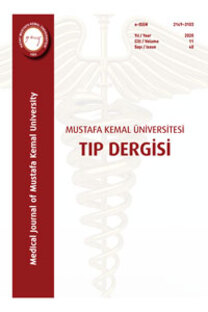Yaşlı Evde Sağlık Hastalarında Malnütrisyon Prevalansı ve Malnütrisyon Riski
Malnutrisyon, yaşlı, evde bakım hizmetleri, beslenme anketleri
The Risk and The Prevalence of Malnutrition in Elderly Home-care Patients
Malnutrition, nutrition screening, Elderly, home-care,
___
- Jagger C, Gillies C, Moscone F, Cambois E, Oyen H, Nusselder W, et al. Inequalities in healthy life years in the 25 countries of the European Union in 2005: a cross-national meta-regression analysis. The Lancet 2008;372(9656):2124–31. https://doi.org/10.1016/S0140-6736(08)61594-9
- Stenholm S, Head J, Aalto V, Kivimaki M, Kawachi I, Zins M, et al. Body mass index as a predictor of healthy and disease-free life expectancy between ages 50 and 75: a multicohort study. Int J Obes 2017;41(5):769–75. https://doi.org/10.1038/ijo.2017.29.
- Hamilton DB. No place like home. [Review of Buhler-Wilkerson, K. No place like home: a history of nursing and home care in the United States. Baltimore: Johns Hopkins University Press, 2001]. Rev Am Hist 2002;30(2):310–5. https://pubmed.ncbi.nlm.nih.gov/12166481/
- Turkish Republic Ministry of Health. [The Delivery of Home Health Care] (in Turkish). 2005. https://www.resmigazete.gov.tr/eskiler/2005/03/20050310-5.htm (Access date:05.04.2021)
- Turkish Republic Ministry of Health. [The directive on the delivery and principles of home health care services offered by the Ministry of Health] (in Turkish). 2011. https://www.saglik.gov.tr/TR,11271/saglik-bakanliginca-sunulan-evde-saglik-hizmetlerinin-uygulama-usul-ve-esaslari-hakkinda-yonerge.html (Access date:05.04.2021)
- Morais C, Oliveira B, Afonso C, Lumbers M, Raats M, Almeida MDV. Nutritional risk of European elderly. Eur J Clin Nutr 2013;67(11):1215–9. https://doi.org/10.1038/ejcn.2013.175
- Crichton M, Craven D, Mackay H, Marx W, Schueren M, Marshall S. A systematic review, meta-analysis and meta-regression of the prevalence of protein-energy malnutrition: associations with geographical region and sex. Age Ageing 2019;48(1):38–48. https://doi.org/10.1093/ageing/afy144
- Ghimire S, Baral BK, Callahan K. Nutritional assessment of community-dwelling older adults in rural Nepal. PloS One 2017;12(2):e0172052. https://doi.org/10.1371/journal.pone.0172052
- Gunduz E, Eskin F, Gunduz M, Bentli R, Zengin Y, Dursun R, et al. Malnutrition in community-dwelling elderly in Turkey: A multicenter, cross-sectional study. Med Sci Monit. 2015;21:2750–6. https://doi.org/10.12659/MSM.893894
- Tori N, Shojaeizadeh D, Sum S, Hajian K. Effect of BASNEF-based nutrition education on nutritional behaviors among elderly people and mini nutritional assessment on nutritional status in elderly with diabetes with type 2 diabetes (A clinical trial intervention). J Educ Health Promot 2019;8(1):94. https://www.ncbi.nlm.nih.gov/pmc/articles/PMC6532392/
- Fernandez-Barres S, Garcia-Barco M, Basora J, Martinez T, Pedret R, Arija V. The efficacy of a nutrition education intervention to prevent risk of malnutrition for dependent elderly patients receiving home care: A randomized controlled trial. Int J Nurs Stud 2017;70(1):131–41. https://doi.org/10.1016/j.ijnurstu.2017.02.020
- Eichler T, Hoffmann W, Hertel J, Richter S, Wucherer D, Michalowsky B, et al. Living alone with dementia: prevalence, correlates and the utilization of health and nursing care services. J Alzheimers Dis. 2016;52(2):619–29. https://doi.org/10.3233/JAD-151058
- Meijers JMM, Schols JMGA, Halfens RJG. Malnutrition in care home residents with dementia. J Nutr Health Aging 2014;18(6):595–600. https://doi.org/10.1007/s12603-014-0006-6
- Mole L, Kent B, Abbott R, Wood C, Hickson M. The nutritional care of people living with dementia at home: A scoping review. Health Soc Care Community 2018;26(4):e485–96. https://doi.org/10.1111/hsc.12540
- Buell JS, Dawson-Hughes B, Scott TM, Weiner DE, Dallal GE, Qui WQ, et al. 25-Hydroxyvitamin D, dementia, and cerebrovascular pathology in elders receiving home services. Neurology 2010;74(1):18–26. https://doi.org/10.1212/WNL.0b013e3181beecb7
- Berggren E, Strang P, Orrevall Y, Odlund Olin A, Tornkvist L. Symptom burden in patients with home care who are at risk for malnutrition: a cross-sectional study. J Palliat Care 2019: 35(2):103-9. https://doi.org/10.1177/0825859719887240
- Geurden B, Franck E, Hartmann M, Weyler J, Ysebaert D. Prevalence of “being at risk of malnutrition” and associated factors in adult patients receiving nursing care at home in Belgium. Int J Nurs Pract 2015;21(5):635–644. https://doi.org/10.1111/ijn.12341
- Lembeck MA, Thygesen LC, Sorensen BD, Rasmussen LL, Holm EA. Effect of single follow-up home visit on readmission in a group of frail elderly patients – a Danish randomized clinical trial. BMC Health Serv Res. 2019;19:751. https://doi.org/10.1186/s12913-019-4528-9
- Adiguzel E, Acar Tek N. Nutrition-related parameters predict the health-related quality of life in home care patients. Exp Gerontol 2019;120:15–20. https://doi.org/10.1016/j.exger.2019.02.018
- Emiroglu C, Gorpelioglu S, Aypak C. The relationship between nutritional status, anemia and other vitamin deficiencies in the elderly receiving home care. J Nutr Health Aging 2019;23(7):677–82. https://doi.org/10.1007/s12603-019-1215-9
- Gil-Montoya JA, Ponce G, Lara I, Barrios R, Llodra JC, Bravo M. Association of the oral health impact profile with malnutrition risk in Spanish elders. Arch Gerontol Geriatr 2013;57(3):398–402. https://doi.org/10.1016/j.archger.2013.05.002
- Sonmez M, Nazik F, Andi S. Home medical care waste collection by caregivers in Turkey. Med Sci Int Med J 2018;7(4):733–5. https://doi.org/10.5455/medscience.2018.07.8872
- Tsuji T, Yamamoto K, Yamasaki K, Hayashi F, Momoki C, Yasui Y, et al. Lower dietary variety is a relevant factor for malnutrition in older Japanese home-care recipients: a cross-sectional study. BMC Geriatr 2019;19:197. https://doi.org/10.1186/s12877-019-1206-z
- ISSN: 2149-3103
- Yayın Aralığı: Yılda 3 Sayı
- Başlangıç: 2010
- Yayıncı: Hatay Mustafa Kemal Üniversitesi Tıp Fakültesi Dekanlığı
COVID-19 Pandemisi Evli Erkeklerin Cinsel Hayatını Nasıl Etkiledi?
MEHMET CANİKLİOĞLU, Levent IŞIKAY, Volkan SELMİ, Sercan SARI, Ünal ÖZTEKİN, Muharrem ÖZKAYA
Serum Copeptin Çocukluk Çağı İdrar Yolu Enfeksiyonlarının Tanısında Kullanılabilir mi?
Mervan BEKDAŞ, Mustafa ERKOCOGLU, ŞEYDA KARABÖRK, Mustafa DILEK
Üre döngüsü bozuklukları klinik, laboratuvar ve genetik özellikleri: Tek merkez deneyimi
COVID-19 hastalarında çinko düzeylerinin incelenmesi
Ağır preeklampsiyi öngörmede hemogram inflamatuar belirteçlerin önemi
Umut KUDRET, Mustafa Doğan ÖZÇİL
Yaşlı Evde Sağlık Hastalarında Malnütrisyon Prevalansı ve Malnütrisyon Riski
Hemoroidektomi Sonrası Üriner Retansiyon: Riski Azaltabilir miyiz?
Fatih GÖKALP, Onur KARSLI, Tamer GÜLSUR
Yunus Emre KUNDAKCI, İsa GÜL, Aysun ATACAN
